-
News & Trends -
Sales -
Marketing Related Topics -
B2B Software Guides Related Topics -
Free Tools & Resources -
- About Us About Us


A sales contract template is a reusable document consisting of prewritten contractual language and blank prompts for personalization. Templates speed up the lead nurturing phase by enabling you to quickly draft sales contracts for each prospect you’re trying to close; all you have to do is fill the prompts with details relevant to the deal. Further, using a template ensures that all your contracts have the language and clauses needed to protect you and your clients.
We created a free general sales contract template that includes the most important elements like identification of parties as well as payment and delivery terms. This template works for most sales situations, but is best suited for ongoing relationships between two businesses. Note that you can create and save your templates in contract management software, and send the final document through the platform. Click the image below to access the customizable template.
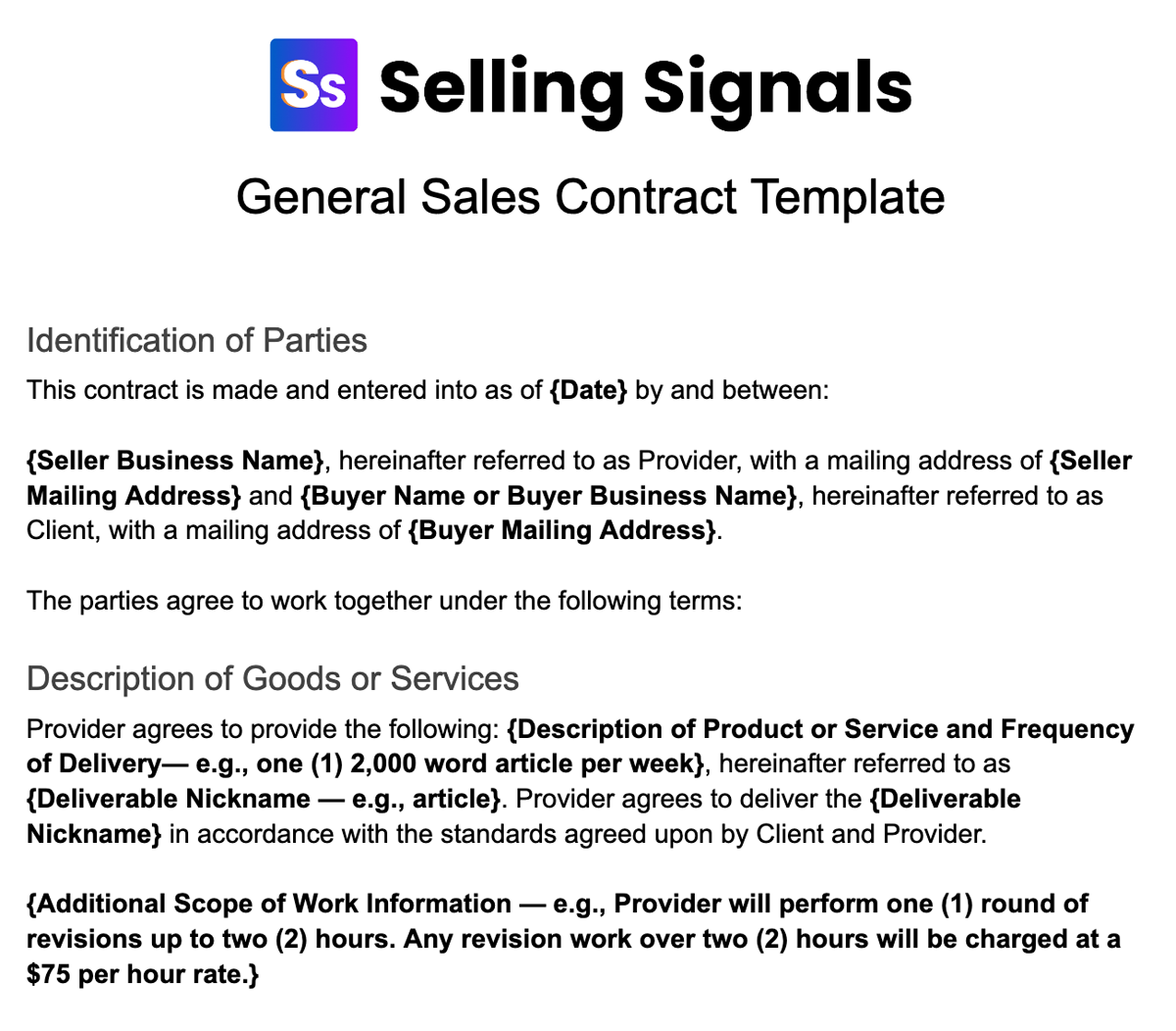
Sales contract templates contain different or additional clauses, aka sections, depending on the nature of the business and its relationships. However, there are some sections that almost every sales contract template, especially ones for ongoing partnerships, should have: identification of parties, description of products and/or services, payment terms, delivery terms, contract period and termination, governing law, and signatures. See each section’s details below.
This section outlines the names of the parties involved in the sale (often the buyer and seller), their addresses, the date the agreement is made, and how each party will be referred to throughout the rest of the contract. For example, in a freelance writer contract, the contract may use “Writer” in place of the business name. This section should end with a contractual statement along the lines of “the parties agree to the following:” to make it legally binding.
Other sales contract templates might include sections for severability, confidentiality, transfer of ownership, notices or communication methods, and amendments. Your combination of sections will depend on the nuances of your relationship with your average customer.
If you’re creating your own sales contract template instead of using a premade one, there’s a five-step process you can follow to build a template. First, pick your sales contract type and select the sections you want to include. Then, review contracts from similar businesses to find ideas and the right legal phrasing. Lastly, write each section of your template, leaving blank prompts for personalization, and ask a legal expert to read it over. Now let’s go into each step.
There are multiple types of sales contracts, each of which is meant for a specific purpose and therefore includes a distinct collection of contract sections. Before you start writing, know the type of relationship your contract is outlining. Is it going to set up renewal terms with current customers or establish a contractual agreement with new business clients? Then, pick the contract type that relates to these needs.
Below are the main types of sales contracts and which types of businesses should use them:
Knowing which type of sales contract you need to use will help you pick the correct sections and find contract templates and examples online that you can borrow inspiration and legal language from. To learn more about how to pick the right type, check out Ironclad’s article on the types of sales contracts, where they illuminate the nuanced differences between each contract type.
There are some contract sections like identification of parties and payment terms that almost every business should include in their contract template. Meanwhile, there are other optional sections, like severability and confidentiality, that might be irrelevant to your average deal. Learn about the possible sales contract sections and decide which ones are important to include.
Here are the common sales contract sections and what they accomplish:
There may be other contingencies you want to create sections to account for. To come up with “what if” scenarios to cover in your contract template, think of experiences with past customers that were confusing to navigate or that resulted in harm to your business. And do research and ask peers about bad experiences. For example, you might find that others in your industry often struggle with late payments, so you decide to outline a late fee provision in the contract.
We offer contract templates in this article that you can use for inspiration, but there are also plenty of others online on websites like PandaDoc, which shares hundreds of legally-binding sales contracts for different industries and situations. For example, they offer one designed specifically for roofing companies, and another for wedding photographers. These examples will give you ideas about what terms to define in your sales contract, and what language to use.
Now that you’ve decided on which sections to put into your sales contract template, start writing your sections inside of a Microsoft Word or Google document. When it’s saved online, you can easily make copies of the template and fill it in for each new customer. Writing legal phrasing can be tough. Almost every word matters, so feel free to copy phrasing from reputable contract templates you found online. Also, include prompts like {Client Name} for easy personalization.
Your contract template is going to serve as the foundation of numerous sales contracts to come, so you need to make sure it’s well-written and covering all the bases. Therefore, it’s best to get someone with a legal background to look it over for loopholes and errors. If you have a friend or company peer who can do so, that’s the best option. But you can also use a service like LegalZoom, which will have a lawyer read over your legal document for a fee starting at $39.
If you follow the above steps you’ll create a reusable sales contact template that includes the right sections and language to protect your business. You’ll also have an easy time filling it out for each individual prospect. Of course, instead of creating one from scratch, you can also start with a professionally-made contract template.
Check out these five free sales contract templates for product-based businesses, statement of work contracts, contract renewals, master service agreement contracts, and order forms. The below templates are for more specific sales scenarios and business types than our general sales agreement template, which can be easily edited or expanded to fit almost any purpose.
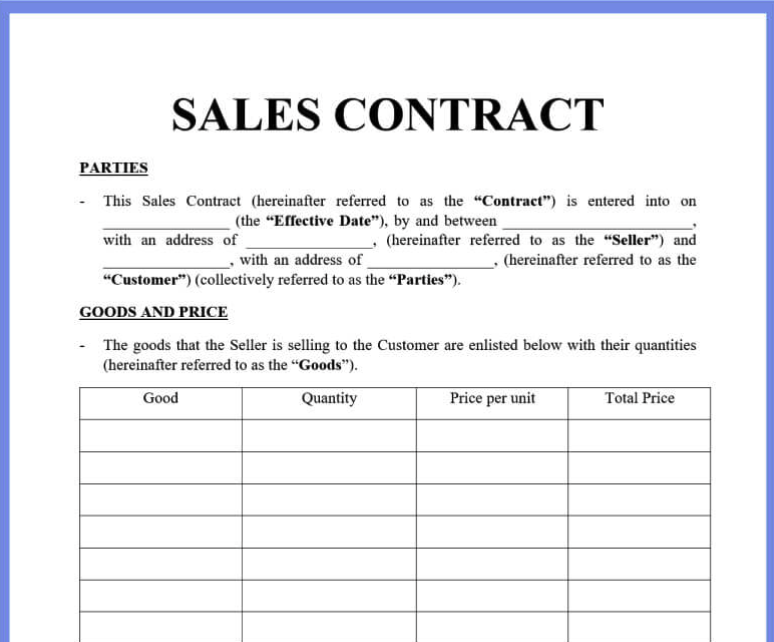
Signaturely’s sales contract template is designed for businesses that sell products. It’s structured as a sales agreement, so it’s slightly similar to our general sales contract template, but ours works well for service-based businesses as well. This template includes all the key sections, but also some specifically meant for product businesses.
As you can see, this template includes a helpful table that you can fill in with descriptions of your goods, the quantity sold, and the prices. On the second page, the template covers product-based business concerns by including sections such as warranties and inspection period, which will give customers peace of mind.
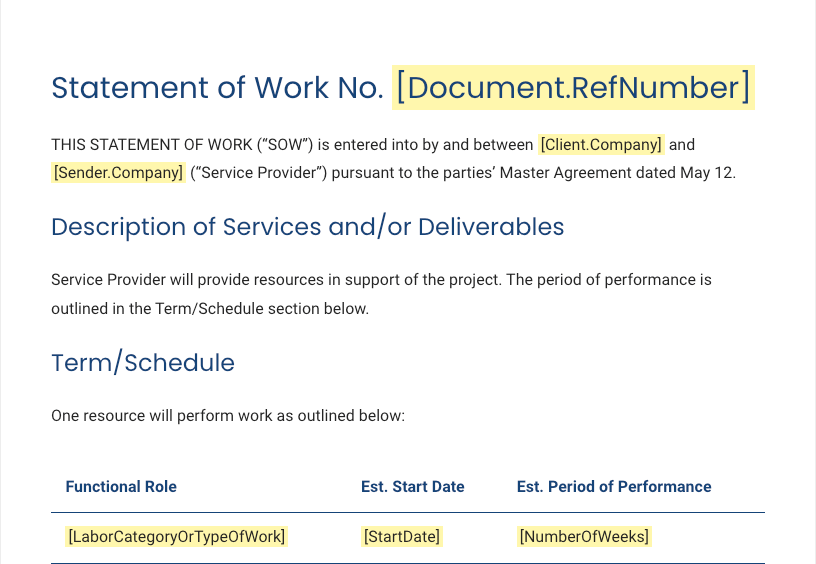
PandaDoc’s Statement of Work (SOW) template is meant for contractors and freelancers who’ll be performing one ongoing project for a client. The template includes sections for identifying parties, describing the project, setting the schedule, defining what’s expected from both parties in this relationship, and signing the SOW.
The template also comes with a section for defining payment terms and methods and another for creating an invoice schedule and outlining who will pay for extraneous expenses like travel or materials. As a bonus, the contract template comes with a well-designed cover page that lends professionalism to the document. One thing to note — some of the template is written from the POV of a freelancer designer, but you can change that writing to fit your own service.
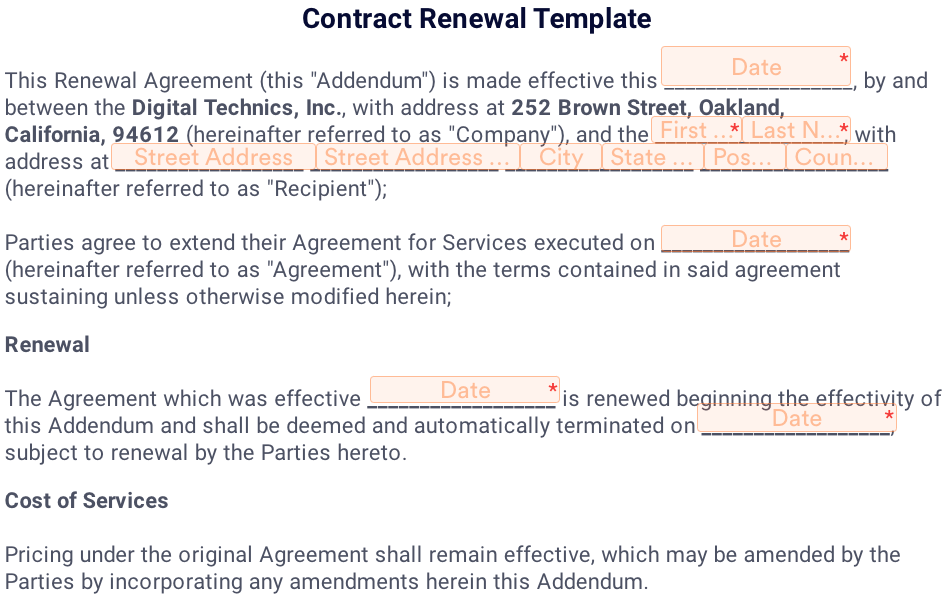
JotForm’s contract renewal template is for businesses that are trying to extend or renew a contract with a current customer. Because there’s already a contract in place, this one is short and simply states that all the terms set forth in that contract are sustained unless otherwise noted in this renewal contract.
The template contains the following sections: parties involved, renewal specifics, cost of services, non-disclosure, and signatures. Consider sending this out to customers you want to extend relationships with, along with a friendly email asking them to continue working with you.
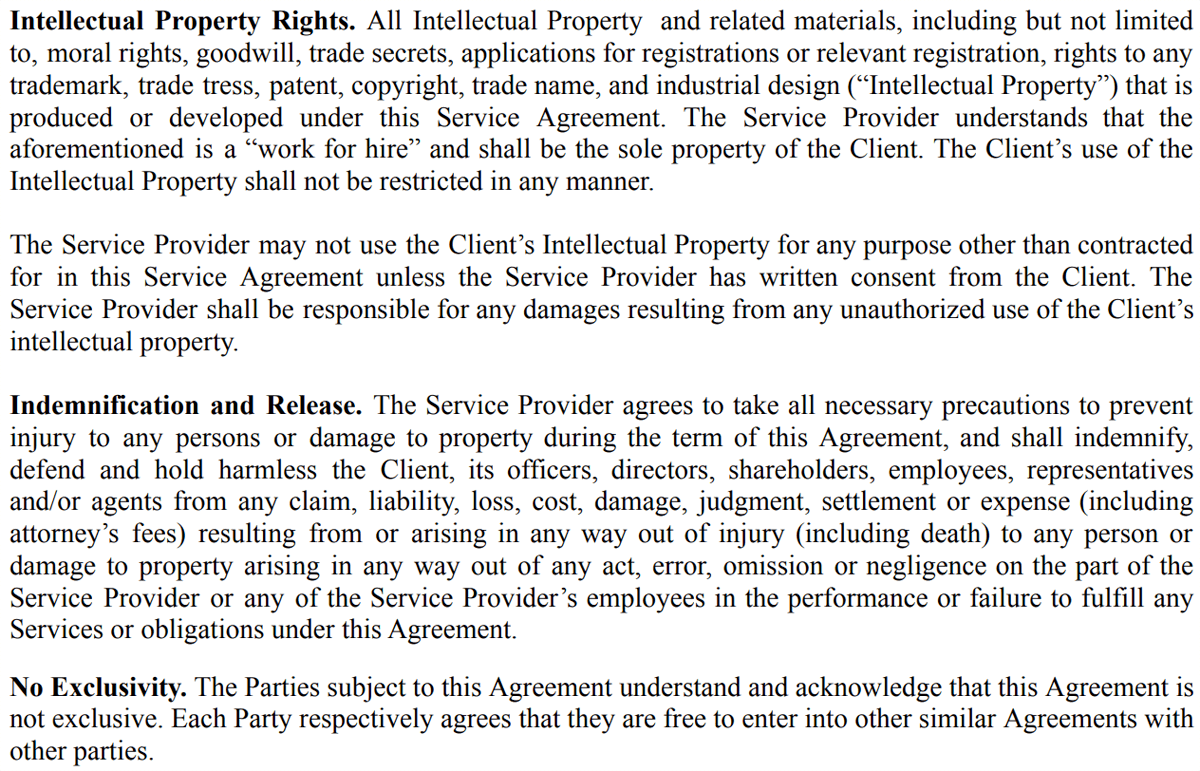
Gonitro’s master service agreement template is for businesses that intend to work with a company over the long term on multiple projects. It’s nine pages and includes legally intricate clauses like confidentiality, insurance requirements, invoice dispute protocols, as well key sections like scope of services, compensation, delivery, and contract termination.
Using a Master Service Agreement (MSA) like this enables you to simply create and send simple 1–2 page statements of work (SOW) contracts whenever you start a new project for the client. In the SOW you’ll simply state that the MSA still governs the relationship.
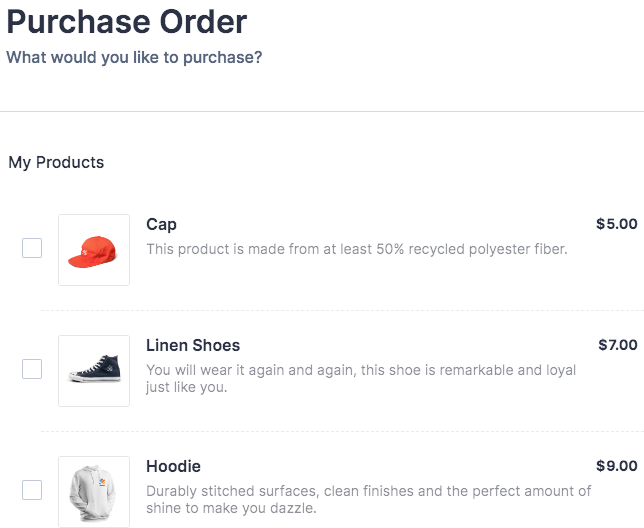
Jotform’s purchase order form template is designed for businesses that sell standardized products or services and want to use the same sales contract for each buyer. The below template is meant to be sent to prospects or embedded on your website.
To place orders, prospects simply fill out the order form with the appropriate information, like their name, email address, shipping address, what they’re buying, and how much. Customize the above template to fit your business’s needs by uploading your product images and adding your branding.
To find more sales contract templates for a variety of business types and sales situations, check out PandaDoc’s template library. Their service is great because you also gain access to a simple editor that allows you to quickly tailor their templates to fit your needs.
When writing a sales contract template, there are some best practices you should adhere to if you want to create the best possible template. They include thinking about your customer’s concerns, using prompts for personalization, leveraging contract management software, and proofreading the document. Read on to learn about each tip.
If you anticipate and address the concerns of your average customer within the contract template it’s less likely that you’ll go into long contract negotiations or scare one away from taking the deal. For example, including a section outlining your warranties will improve the customer’s confidence in you and make them feel like you’re looking out for them. As you write, remember that the contract is meant to protect both you and the customer.
Prompts are the parts of the template that you fill in when you personalize it to a specific customer. A good prompt won’t just be a blank space. It will instruct users about what to write. For example, a prompt could be {Date Contract Goes Into Effect} or {Product Size}. Make sure your template uses a prompt as a placeholder for any information that changes from customer to customer.
Alongside helping you send, negotiate, and store your completed contracts, a contract management software platform like [fitlink slug="pandadoc-main"]PandaDoc[/fitlink] comes with pre-written contract templates that you can alter and design to fit your business’s specific needs. Check out our article on the best contract management software for salespeople, where we break down their pricing, features, and use cases.
Your sales contract template is hopefully going to turn into a lot of real sales contracts. Always proofread and double-check it to make sure there aren’t any confusing sentences or words that might be misunderstood or misinterpreted by your customer or a court official. Here’s a guide by Express Proofreading describing how to proofread a legal document. Get some of your peers to look at it as well, especially those with legal experience or an eye for details.
If you follow the above tips and the five-step process we outlined earlier in the article, you’ll create a sales contract template that promotes mutually beneficial relationships between you and your customers.
A well-written sales contract template with the right clauses will help you quickly draft personalized sales contracts that prospects can sign once they’re through the nurturing phase and ready to buy your solution. You’ll protect your business and avoid the unfortunate situation of a customer getting cold feet while waiting for you to write up a contract from scratch. For more on this topic, read our article on how to create a sales contract for an individual customer.


Sam is a former SaaS sales rep turned freelance writer. He spent his career selling real estate technology to C-suite executives before switching over to blogging, where he now covers sales, marketing, and small business topics. Sam specializes in lead generation, lead nurturing, and deal closing articles for Selling Signals. When he’s not researching the latest sales trends, he’s either penning short stories, hiking, or reading in NYC’s Washington Square Park.

Selling Signals delivers actionable advice for sales and marketing professionals. Learn strategies that help you hit targets, strengthen customer relationships, and win more business. Get expert advice on lead generation, sales processes, CRM software, sales management, and account management directly to your inbox.
Property of TechnologyAdvice. © 2026 TechnologyAdvice. All Rights Reserved
Advertiser Disclosure: Some of the products that appear on this site are from companies from which TechnologyAdvice receives compensation. This compensation may impact how and where products appear on this site including, for example, the order in which they appear. TechnologyAdvice does not include all companies or all types of products available in the marketplace.